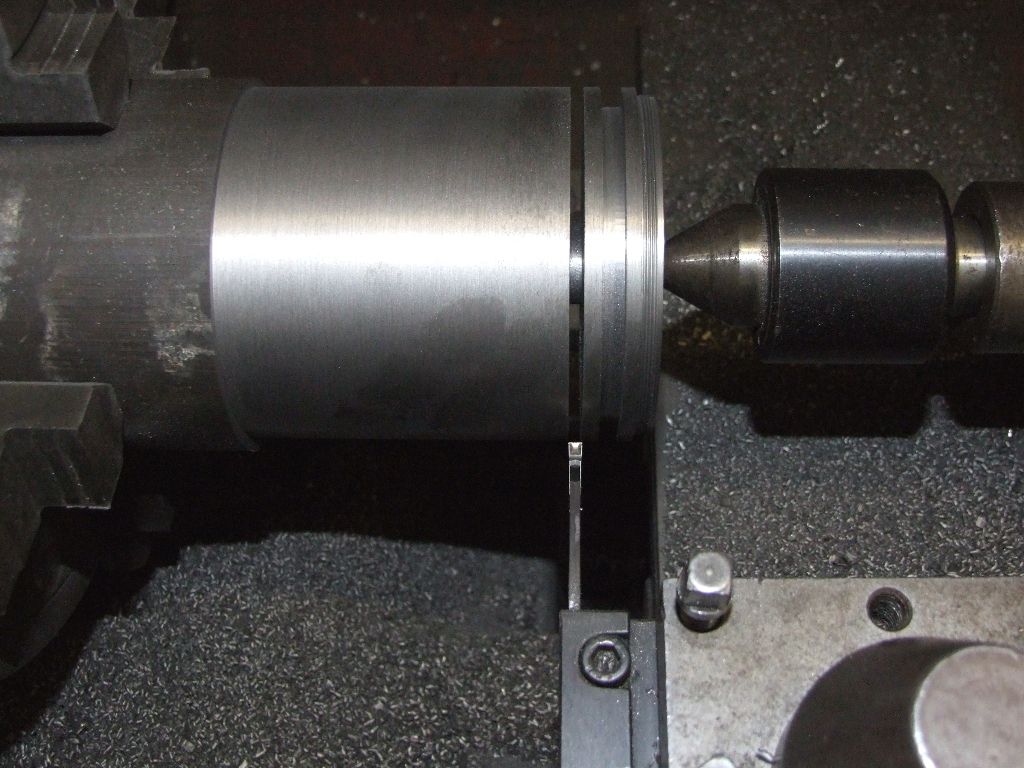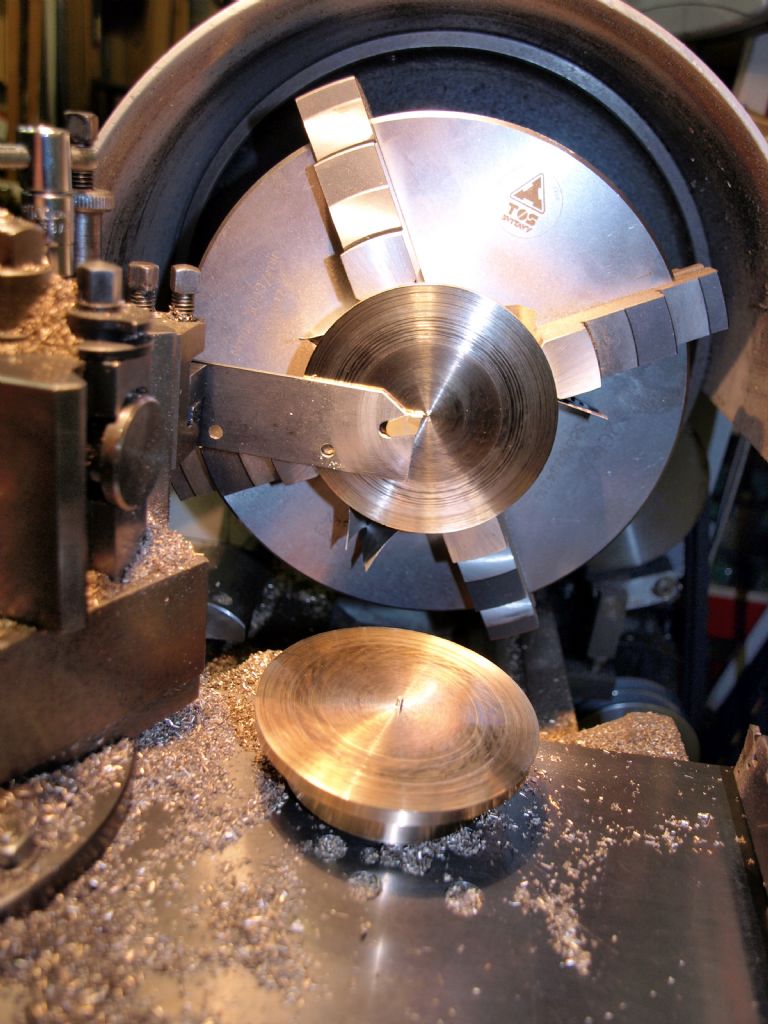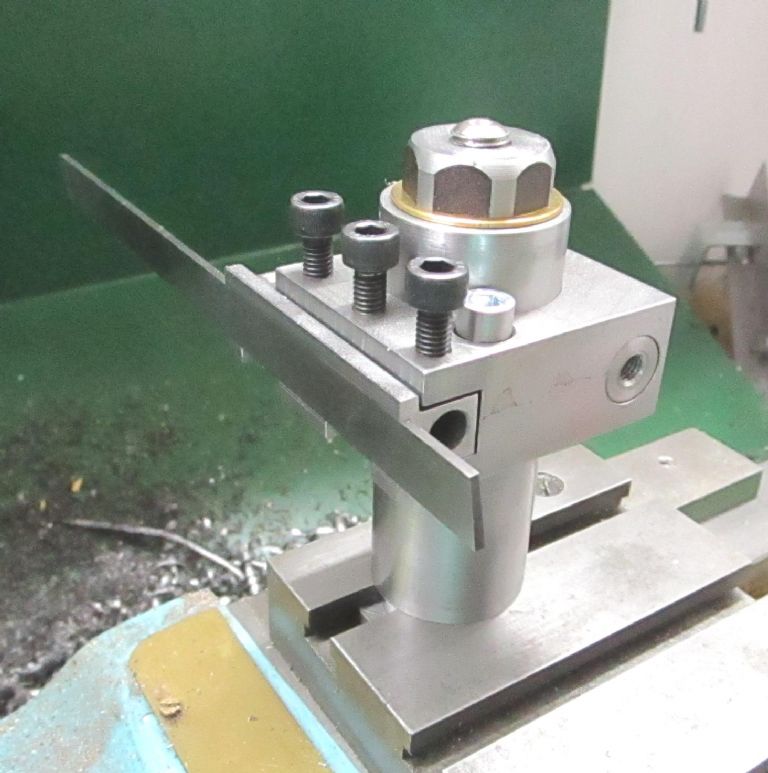Yet another parting-off question
| Robin Graham | 17/05/2020 00:21:57 |
| 1089 forum posts 345 photos | It's a well-worn topic I know, but... After breaking a couple (or more) tools I have developed some sort of 'feel' for parting - I don't understand things well enough to be confident with power feed, but by hand I can usually tell when the tool isn't happy, withdraw and adjust things. My weapon of choice is the NCIH 19-2 carbide insert blade from ARC which I've found fine for parting up to two inches in steel, brass and aluminium, although the spec on ARC's site gives 38mm as the maximum diameter for the work. Today I pushed things even further and tried parting a disc from three inch diameter alumimium bar - the rule marks on the blade give 47mm as the maximum protrusion, so - why not give it a go? The reason for the (perhaps inevitable) bang was that despite my best efforts to square the tool up, it wandered towards the headstock - when I sawed the piece off it was square for about an inch on radius, but then 'dished'. My question is - can I part 3" diameter with the right tool and technique, or am I wasting time trying? Lathe is a generic 12X36 - I lock the saddle so I'm pretty sure that's not the problem. Robin
Edited By Robin Graham on 17/05/2020 00:25:25 |
| Nigel Graham 2 | 17/05/2020 01:40:12 |
| 3293 forum posts 112 photos | Well, you do seem to admit pushing the tool and machine beyond recommended! The tool setting needs to be spot-on, and the whole set-up and machine rigid. Some, including me, swear by using a rear tool-post but others would say that's not necessary. I think that may be so on a large lathe but one problem on a smaller machine is the cross-slide having sufficient engagement for rigidity when an over-long parting-tool is used in the normal tool-post. If you were using an HSS blade I'd ask if you'd made the mistake I did for a long time, of grinding the tool on an angle to try to obviate a large pip on the parted-off side. It should be square across. You are using inserts though, so the tool shape would be all-correct. Right tip for the material? Carbide inserts come in variety counts that leave Heinz standing, and the wrong tip type for the metal might affect things by demanding slightly more force than should be necessary. Trying to part off in a single cut? I generally ease matters by cutting a wider groove in steps so some of the blade flank is in the open air, but beware of chips jamming in the gap. They shouldn't but still keep an eye on things. Don't set the blade out from the holder all in one go, but in a few steps to minimise the amount of metal removed at full stretch. Is the blade-holder correct for the blade and tool-post? The tool may be fully square to the lathe axis but a slight angle from the tip's vertical centre-line will upset its geometry, putting one corner very slightly high and the other very slightly low and possibly causing the tool flank to rub on the groove wall. That could well push the tool off the straight-and-narrow. I am not sure what else it may do, but it won't help matters anyway! Use plenty of cutting-fluid. That often recommended for aluminium is paraffin or WD-40 - if nothing else they are are handy for removing the lubricating-oil from the slides. A light, neat cutting-oil or even thin lubricating-oil may be better as it lubricates the blade as well as the tip itself, and tends to tarry longer in the cut. The dishing effect is very hard to avoid , and sometimes I resign myself to parting a bit over-length and facing off. It comes from the blade flexing, possibly due to that vertical-plane error or to axial square-ness being a tiny bit out; or from the cross-slide rotating a tiny amount by wear or mis-adjustment. I have probably encountered the latter when facing a large diameter. Both problems will be magnified by very long parting-tool overhangs. Watch out for the whole tool-post creeping round. It can happen - as I have found - due to the cutting force being a long way from the tool-post pin, and highly off-set from it. Hope this lot helps! |
| Hopper | 17/05/2020 02:26:35 |
7881 forum posts 397 photos | 3 inches is pretty ambitious to be sure. If its cutting dished its often due to either tool or tip not sitting perfectly square or the cutting edge is not perfectly square to the blade. Or blade is not held perfectly vertical. You might check the tool set up with a dial indicator to get it spot on for such extreme work. Good idea posted above to widen the gap as you progress. BTW an inverted parting tool helps a lot too. Lets the chips fall out before they jam up. Plus supposed better geometry about which i am not sure. But certainly chip evacuation alone is beneficial. Edited By Hopper on 17/05/2020 02:29:17 |
| Thor 🇳🇴 | 17/05/2020 05:39:19 |
1766 forum posts 46 photos | Hi Robin, Have you tried the NCIH 19-3 carbide insert blade for parting off 3 in. diameter work? I found that the 2mm blade will flex more than the 3mm. Thor |
| JasonB | 17/05/2020 07:14:34 |
25215 forum posts 3105 photos 1 articles | With a 12" lathe you would be better off going up to a 26mm blade rather than the smaller 19mm which are primerily aimed at bench top lathes with a smaller max tool height such as what ARC sell. The extra depth combined with the increased thickness of a 3mm insert holder will help with stiffness. As for lining up the tool if there is any slight play in the ways which there must be for them to move then the cutting force will tend to rotate the tool slightly away from the unloaded state that you are likely to have set it at. Any slight wear on one side of teh insert compared with teh other will also see it wanting to go its own way ARC tend to test their own product both in house and by getting known users to report back, the specs they give are based on what they find the items capable of hence their max diameter is less than whats on the tool
As for breaking the tools worth reading what is on ARC's site Caution: Safe blade extension outside the holder is dependent on various factors which include machine rigidity and the material being machined. Extending the blade beyond the number 2 (which represents approx. 2cm in from the cutting edge) on the scale increases the risk of vibration and tool breakage. Edited By JasonB on 17/05/2020 07:25:32 |
| S.D.L. | 17/05/2020 07:49:29 |
| 236 forum posts 37 photos | Have you checked that the insert hasnt chipped / worn on one side leading it to wander. Its better with power feed you need to cut not rub.
Steve |
| not done it yet | 17/05/2020 08:15:42 |
| 7517 forum posts 20 photos | All lathes will (or should) cut a flat or very slightly dished cross cut - think here that nothing you face off wobbles, when stood on end (it is either perfectly flat or slightly concave). Try engineer’s blue to test the contact of your lathe’s output for this, or place a straight-edge across a large diameter face cut. As the vast majority cut very slightly dished, the problems of parting are compounded as the depth of cut increases. I expect you have simply passed the limit for your machine and tool. Widen the parting groove cut over the first 25mm or so and the problem may well be solved. |
| Andrew Johnston | 17/05/2020 09:03:00 |
7061 forum posts 719 photos | Posted by Robin Graham on 17/05/2020 00:21:57: My question is - can I part 3" diameter with the right tool and technique, or am I wasting time trying? Shouldn't be a problem. Although I didn't completely part off the item shown below due to the overhang and tailstock support I had no problem cutting the groove: The OD is 3-3/8" and material is cast iron. Andrew |
| Ketan Swali | 17/05/2020 10:00:55 |
| 1481 forum posts 149 photos | Just a few notes to add to this discussion.... Andrews comments are correct for the holder he is using (probably ISCAR or similar at a guess), combined with the rigidity of his machine and set-up, which in his picture shows that it is supported with a live centre, which helps in the rigidity of the set-up for his purpose. His experience in using the tool is also to be taken into consideration. The comments on our website regarding maximum diameter, rigidity, etc., are based on the tests I did many moons ago on a C3, SC3, and C6, using a variety of materials for the tests, where I used and abused the blade/set-up to understand the limitations. I must say that I did not support the stock with a live center. Perhaps something I failed to take into account. After reaching a certain point of use/abuse, I gave the same blades to Neil as well as to the late John Stevenson. Both were more happy with the results then I was. the limitation comments on our site are based on the results of the tests. More discussions about the blade holder material are on this old thread. It would help Robin to read both pages of that thread to add an additional dimention - understanding of the behaviour of this type of insert tool, depending on the material of the holder. Ketan at ARC |
| KWIL | 17/05/2020 10:02:32 |
| 3681 forum posts 70 photos | +1 I have cut similar diameter in PB, again like Andrew, the lathe in use was a Harrison M300
|
| mechman48 | 17/05/2020 10:22:25 |
2947 forum posts 468 photos | +1 for all comments above. I have 4 parting off blades set up, 3mm HSS 'T' shape, - 2mm carbide insert, & a 1.3mm HSS small blade hand ground for small tiny stuff or grooves & finally a rear tool post set up with 2mm HSS blade which I prefer to use for large diameter material ( Hemingway kit ), all work well under hand / power feed. Have a look in my album ' Rear parting tool post' if you're interested in the post & set up. George. |
| Eric Cox | 17/05/2020 10:44:49 |
557 forum posts 38 photos | I had the same problem with a dished profile when parting off even on 1" dia.. Turned out (excuse the pun) that the tool post wasn't tight enough and was creeping round.
|
| thaiguzzi | 17/05/2020 10:55:32 |
704 forum posts 131 photos | Guys, the OP's lathe is a generic 12x36. That is Colchester Student/Triumph, Harrison M300 territory. All the above lathes inc the OP's should comfortably part off 3" OD Ally. And more. We are not talking flat slideways Myford S7's here. If i can do it on my weedy Boxford either with HSS or 3mm carbide tips from the front, there is plainly something wrong with the OP's tool, tooling or technique. |
| Ketan Swali | 17/05/2020 11:04:59 |
| 1481 forum posts 149 photos | Posted by thaiguzzi on 17/05/2020 10:55:32:
If i can do it on my weedy Boxford either with HSS or 3mm carbide tips from the front, there is plainly something wrong with the OP's tool, tooling or technique. With respect, 'the guys' on this thread and the old thread I linked to are trying to assist the OP to help him answer the question. Ketan at ARC |
| John Baron | 17/05/2020 11:15:09 |
520 forum posts 194 photos | Hi Guys, Just to add my two pennyworth I have a Myford S7 and use a rear mounted tool post with a 2 mm thick 12 mm wide blade. I have parted 50 mm diameter EN1 with it but I wouldn't like to go any bigger even in aluminium. Ensuring that the tool is dead square in both directions is vital as is getting the blade hight so that its cutting on centre. The picture shows my rear tool post and parting blade.
|
| Ketan Swali | 17/05/2020 11:15:18 |
| 1481 forum posts 149 photos | The biggest single problem on forums is 'PRESUMPTION'. There is more to a subject than simply that there is 'something wrong with the OP's tool' as being the first port of call. Ketan at ARC. |
| Tony Pratt 1 | 17/05/2020 11:34:24 |
| 2319 forum posts 13 photos | To the OP, use a new neutral tip i.e. not RH/LH on centre height, only enough blade extension to do the job, check all slides are 'just right', use power feed & flood coolant, finally can you increase the RPM as you go in? My lathe has a variable speed so I am able to do this? Also is your tool post rigid enough? Tony Edited By Tony Pratt 1 on 17/05/2020 11:35:21 |
| JasonB | 17/05/2020 11:58:20 |
25215 forum posts 3105 photos 1 articles | Posted by thaiguzzi on 17/05/2020 10:55:32:
Guys, the OP's lathe is a generic 12x36. That is Colchester Student/Triumph, Harrison M300 territory. All the above lathes inc the OP's should comfortably part off 3" OD Ally. And more. We are not talking flat slideways Myford S7's here. If i can do it on my weedy Boxford either with HSS or 3mm carbide tips from the front, there is plainly something wrong with the OP's tool, tooling or technique. The lathe is comfortable with it but the OP is using a tool best suited to a smaller machine and smaller diameters, I note you are using 3mm and probably 26 or 32mm deep which as has been shown will be upto the job and already suggested by others His question was "can I part 3" with the right tool", answer is that 3" can be parted with the right tool unlike the wrong tool he has, rest is up to him. Edited By JasonB on 17/05/2020 12:00:40 |
| Former Member | 17/05/2020 13:35:08 |
[This posting has been removed] | |
| old mart | 17/05/2020 17:00:43 |
| 4655 forum posts 304 photos | I would use a 3mm wide 32mm blade for that size. I have studied both Kennametals and Kyoceras instructions on setting up blades for industrial parting, and they both say 0.004" ABOVE centre line when parting solid. Also, I would use my shop made rear inverted parting setup which is noticeably more stable, stiffness is of great importance. Edited By old mart on 17/05/2020 17:05:40 |
Please login to post a reply.
Want the latest issue of Model Engineer or Model Engineers' Workshop? Use our magazine locator links to find your nearest stockist!
Sign up to our newsletter and get a free digital issue.
You can unsubscribe at anytime. View our privacy policy at www.mortons.co.uk/privacy
- *Oct 2023: FORUM MIGRATION TIMELINE*
05/10/2023 07:57:11 - Making ER11 collet chuck
05/10/2023 07:56:24 - What did you do today? 2023
05/10/2023 07:25:01 - Orrery
05/10/2023 06:00:41 - Wera hand-tools
05/10/2023 05:47:07 - New member
05/10/2023 04:40:11 - Problems with external pot on at1 vfd
05/10/2023 00:06:32 - Drain plug
04/10/2023 23:36:17 - digi phase converter for 10 machines.....
04/10/2023 23:13:48 - Winter Storage Of Locomotives
04/10/2023 21:02:11 - More Latest Posts...
- View All Topics
- Reeves** - Rebuilt Royal Scot by Martin Evans
by John Broughton
£300.00 - BRITANNIA 5" GAUGE James Perrier
by Jon Seabright 1
£2,500.00 - Drill Grinder - for restoration
by Nigel Graham 2
£0.00 - WARCO WM18 MILLING MACHINE
by Alex Chudley
£1,200.00 - MYFORD SUPER 7 LATHE
by Alex Chudley
£2,000.00 - More "For Sale" Ads...
- D1-3 backplate
by Michael Horley
Price Not Specified - fixed steady for a Colchester bantam mark1 800
by George Jervis
Price Not Specified - lbsc pansy
by JACK SIDEBOTHAM
Price Not Specified - Pratt Burnerd multifit chuck key.
by Tim Riome
Price Not Specified - BANDSAW BLADE WELDER
by HUGH
Price Not Specified - More "Wanted" Ads...
Do you want to contact the Model Engineer and Model Engineers' Workshop team?
You can contact us by phone, mail or email about the magazines including becoming a contributor, submitting reader's letters or making queries about articles. You can also get in touch about this website, advertising or other general issues.
Click THIS LINK for full contact details.
For subscription issues please see THIS LINK.
Model Engineer Magazine
- Percival Marshall
- M.E. History
- LittleLEC
- M.E. Clock
ME Workshop
- An Adcock
- & Shipley
- Horizontal
- Mill
Subscribe Now
- Great savings
- Delivered to your door
Pre-order your copy!
- Delivered to your doorstep!
- Free UK delivery!














 Register
Register Log-in
Log-in


